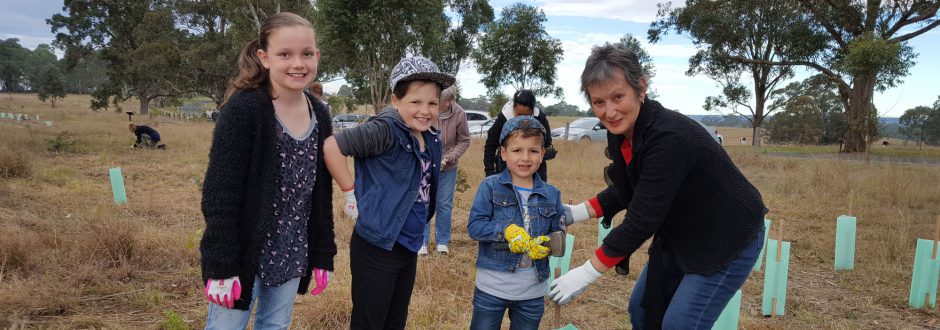Ten threatened species have been found on the Good Samaritan Sisters’ Mater Dei site at Camden, NSW, in the first official survey of birds and wildlife since concerted efforts began on the site to conserve the precious tract of Cumberland Plain Woodland.
The survey, which identified six threatened bird species, three threatened microbats and a threatened native snail, is a joyful affirmation of the Sisters’ decision to embark on the ambitious Wivenhoe Conservation Project to restore 190 hectares of the endangered ecosystem on the Mater Dei property, as part of their commitment to care for creation.
In 2012, the Sisters signed a formal agreement with the NSW Minister for the Environment, declaring 26 hectares of the property a ‘BioBank’ site. Under the BioBanking Agreement, the NSW Office for the Environment and Heritage (OEH) provides funds for the gradual restoration of the land. Each year, agreed outcomes, such as the removal of feral animals and weeds and regeneration of native species, must be achieved so that money can be released for further work. A second BioBank site on the property has just been commissioned, with work and funding set to begin soon.
Kathryn Collins, Senior Conservation Assessment Officer with the NSW Office of Environment and Heritage, said the survey result is wonderful news.
“These sorts of results show how important the woodlands at Mater Dei are, and the fantastic work that is being done to restore them,” she said.
“This site is probably one of the largest areas of Cumberland Plain Woodland in private ownership in western Sydney and this survey shows just what an important site it is and how it is home to many important and threatened species.”
Kathryn said that over a period of about a week-and-a-half, the survey was carried out using a number of methods. They included setting up motion-activated remote cameras throughout the bushland as well as ultrasonic bat detectors, called ‘Anabat’. Bird surveys were undertaken through the day and at night, and recordings of different owl calls were played, to record whether there was any response. Spotlighting at night was also employed, to try and detect nocturnal birds and arboreal mammals.
The survey identified the presence of the Powerful Owl, Little Lorikeet, Speckled Warbler, Little Eagle, Dusky Woodswallow and Varied Sittella, all of which are threatened bird species. The three threatened microbats identified were the Eastern Bentwing-bat, East Coast Freetail-bat and Large-eared Pied Bat. Two snail species were seen, one of which was thought to be the threatened Cumberland Land Snail.
Judith Holt, who is Coordinator of the Community Engagement and Education Sub-Committee of the Wivenhoe Conservation Board, was present for one of the night surveys and said it was a fascinating experience.
“I hadn’t ever been on a night walk for a species survey before,” she said. “And it was really interesting.”
With miners’ lamps on their heads, the group spread out along the walking tracks and across the woodlands, scanning the trees or the ground, locating the remote cameras and broadcasting owl recordings.
“We got some calls back, which was amazing,” she said. “So we did experience a lot of the techniques that the survey report talks about. It was a very focused, very busy, but very enjoyable experience.”
Michael McDonald, the Good Samaritan Sisters’ Resources and Business Services Manager, said he was overjoyed by the identification of so many threatened species on the site.
“It’s a terrific affirmation of the commitment of the Sisters to creation as part of their mission,” he said. “And it’s an acknowledgement of not just the natural beauty that exists on that site, but its biodiversity, and it confirms that it is supporting endangered fauna, that’s quite wonderful.
“We are now custodians of preserving these rare species along the Cumberland Plain corridor so that young people who won’t have known the natural environment for that part of Sydney, will be able to come, see, visit and learn the natural history of the area. It’s a gift for many generations.”
That gift for the future was consolidated further when a group of about 30 local volunteers, Good Samaritan Sisters, and the Wivenhoe Conservation group joined the experts from Toolijooa Environmental Restoration, who are carrying out the conservation works, to celebrate National Tree Day (July 31) by planting 2,000 young native trees and low level shrubs.
Good Samaritan Sister Bernadette Corboy, who took part in the day, said the plantings would not only restore some of the native habitat so necessary to the endangered species and other animals, but it was also a sign that the local community was learning more about the conservation effort and beginning to take ownership of it.
“The knowledge and awareness of what we’re doing is growing,” she said. “The tree planting was a wonderful community day, building on the regular monthly tree plantings which are helping people to come to know more about what’s happening on the site and embrace it.”
Keep up to date about community planting days, workshops and other activities at the Wivenhoe Conservation Project via their Facebook page.
